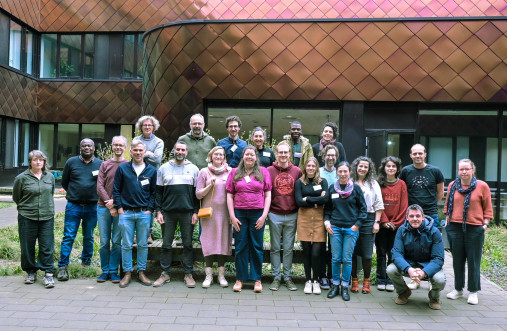Two years into B-Cubed, we met for our annual meeting from 25-27 March. Hosted by the German Centre for Integrative Biodiversity Research (iDiv) Halle-Jena-Leipzig, the event included two days of internal discussions and a workshop with policy advisors, data scientists, and conservationists.
On 25 March, we held demo sessions showcasing available B-Cubed tools:
-
A new GBIF service for downloading species occurrence data as standardised cubes for modelling and indicators.
-
R packages for calculating biodiversity indicators from occurrence cubes.
As more results emerge, we’re developing comprehensive guides and organising training events (watch recordings here).
On 26 March, we planned the application of B-Cubed tools in four case studies:
|
1. Testing workflows on GBIF data for Flanders, including trends in regulated species, invasive species pressure in protected areas, and phylogenetic diversity mapping. |
|
2. Using B-Cubed data cubes and indicators for bioinvasion status reports by the South African National Biodiversity Institute (see reports). |
|
3. Applying B-Cubed indicators to species and regions of interest for international environmental agreements. |
|
4. Enhancing GBIF data integration for reporting under Article 17 of the Habitats Directive. |
We also hosted two plenary talks open to iDiv colleagues: Quentin Groom on FAIR biodiversity data and Lucy Bastin (AD4GD) on landscape connectivity.
On 27 March, we held a B-Cubed workshop on bridging biodiversity data and decision-making.
Setting the scene
Quentin Groom opened with how B-Cubed makes biodiversity data actionable through data cubes and the EBV framework for modelling and indicators. Lina Estupinan followed with insights from our EU stakeholder consultation, stressing the importance of verifying—not assuming—user needs. She also reviewed the growing biodiversity legislation and its rising data demands, highlighting challenges in the science-policy interface, such as mismatched research and policy cycles, raising questions on how newly generated datasets can be used in relation to decade-old policies.
The workshop brought together representatives from projects like BioAgora, EuropaBON, BioDT, AD4GD, GuardIAS, and BMD, as well as from relevant organisations such as the European Environment Agency and national contact points. We had the chance to learn more about BioAgora, EuropaBON and the data flows related to Natura 2000.
Marie Vandewalle outlined BioAgora’s development of the Science Service for Biodiversity, which is to be fully functional by 2027, stressing the shift from using science to justify policies to using it to inform them. She also highlighted relevant initiatives such as Eklipse, Biodiversa+, RESPIN and COOP4CBD.
Henrique Pereira presented EuropaBON's framework for monitoring biodiversity and ecosystem services, stressing the critical need to involve stakeholders throughout the process. More on EuropaBON's work here.
Brigitte Braschler from iDiv reviewed the main Natura 2000 data flows and sufficiency assessments, highlighting current data challenges and the role of standardised data in overcoming them.
The role of cubes in policy
In the workshop’s second part, Andrew Rodrigues (GBIF) and Hanno Seebens (JLU) showcased the new GBIF data cubes download function and our R packages for calculating biodiversity indicators from occurrence cubes. Stakeholders provided valuable feedback on improving these tools to better meet user needs.
B-Cubed case studies
We then presented our case studies and collected input on potential enhancements.
Thank you to all participants for joining our workshop and to the organisers for hosting us in Leipzig!
